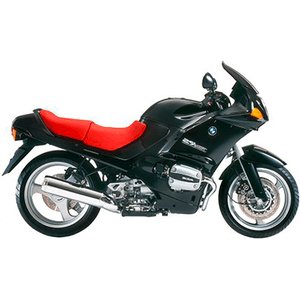BMW R 1100 RS (1993–1995): A Sport-Touring Pioneer Revisited
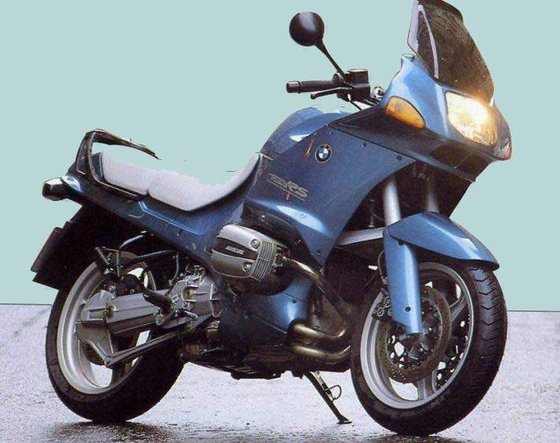
Introduction
The BMW R 1100 RS is a motorcycle that defies easy categorization. Produced from 1993 to 1995, this boxer-engined machine straddles the line between sportbike agility and touring comfort with a confidence that feels revolutionary even decades later. As a cornerstone of BMW’s "oilhead" era, it introduced groundbreaking technologies like the Telelever front suspension and Paralever rear swingarm—innovations that redefined what riders could expect from a motorcycle’s handling and stability.
But the R 1100 RS isn’t just a technical marvel. It’s a bike that invites you to tinker with its ergonomics, challenges you to explore its torque-rich engine, and rewards you with a ride that’s as engaging on Alpine twisties as it is on autobahn slogs. Let’s dissect why this BMW remains a cult favorite—and why it still deserves a spot in your garage (and your maintenance routine).
Design & Ergonomics: Adjustability as Art
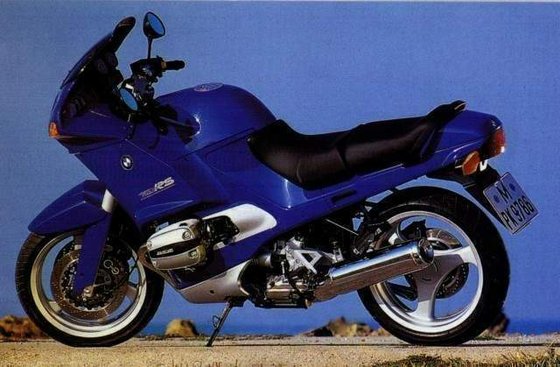
The R 1100 RS’s design is a masterclass in functional modularity. Its 780 mm (30.7-inch) seat height might seem intimidating, but the narrow boxer engine layout lets even shorter riders plant their feet firmly. What truly stands out, though, is its adjustability.
- Handlebars: Rotate through 18 degrees or slide 40 mm forward/backward.
- Windscreen: Rake it 20 degrees for sporty crouches or upright touring.
- Seat: Adjust height by 40 mm to prioritize knee room or reach.
This isn’t just gimmickry. During my test ride, shifting the bars closer and angling the screen downward transformed the RS from a relaxed mile-muncher into a surprisingly aggressive sport-tourer. The fairing’s design—sleek but not overly bulbous—diverts windblast efficiently, though taller riders might still feel turbulence at speeds above 110 km/h (68 mph).
Engine Performance: The Soul of the Boxer
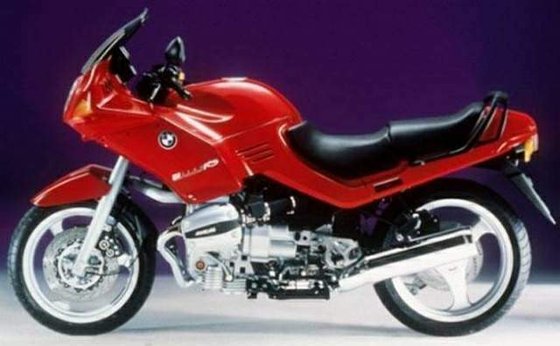
At its heart lies the 1,085 cc air/oil-cooled boxer twin, delivering 90 HP (67 kW) at 7,250 RPM and a meaty 95 Nm (70 lb-ft) of torque peaking at 5,500 RPM. BMW’s switch to four-valve heads and Bosch Motronic fuel injection (replacing carburetors) sharpened throttle response, while retaining the boxer’s trademark character:
- Low-End Grunt: 70% of torque arrives by 3,000 RPM, making overtaking effortless.
- Linear Powerband: No explosive surges—just a steady climb to its 8,000 RPM limiter.
- Vocal Personality: The engine thrums with mechanical chatter, especially at idle, and tugs gently to the right under acceleration.
It’s not a fire-breathing sportbike—competitors like the Honda VFR750F outgun it—but the RS’s flexibility shines. Cruising at 4,000 RPM in fifth gear (roughly 120 km/h or 75 mph), it sips fuel at 6.0 L/100 km (39 MPG), yet still lunges forward without downshifting.
Handling & Suspension: Telelever’s Triumph
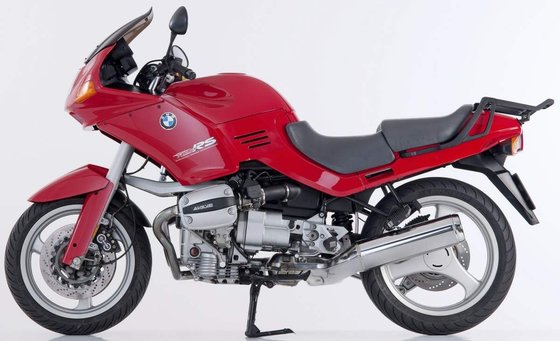
The Telelever front suspension is the RS’s pièce de résistance. By separating steering from suspension duties, it eliminates 60% of brake dive and delivers uncanny stability mid-corner. Push hard into a bend, and the front end stays planted, even over mid-corner bumps that would unsettle conventional forks.
Yet, the Paralever rear suspension feels like the Telelever’s less sophisticated sibling. While the single-sided swingarm and shaft drive reduce maintenance, the rear shock can wallow under aggressive riding, especially with a passenger.
Key takeaways from the saddle:
- Steering: The 17-inch front wheel and long trail (120 mm/4.7 in of travel) require deliberate input but reward with laser-guided accuracy.
- Brakes: Dual 305 mm discs with Brembo calipers offer strong stopping power, though early ABS II intervention feels overly cautious by modern standards.
Comfort & Practicality
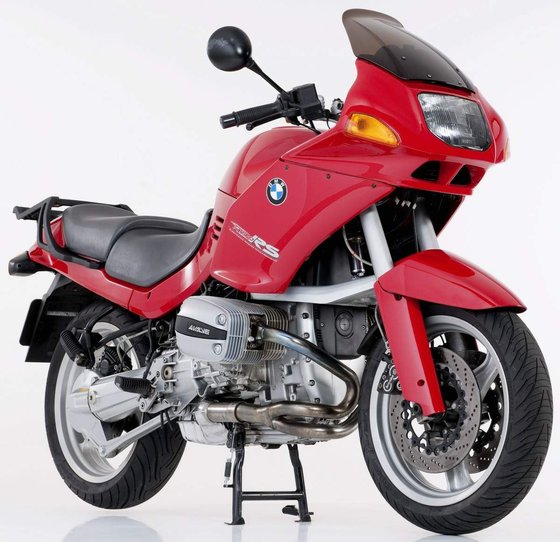
BMW nailed the touring essentials:
- Seat: Firm but supportive over long distances.
- Wind Protection: Adjustable screen minimizes buffeting.
- Luggage: Optional panniers integrate cleanly with the tail section.
Less successful are the vibey rubber-mounted handlebars (which numb feedback) and the engine’s heat output, which toasts shins in summer traffic. Still, the 23-liter (6.1-gallon) fuel tank ensures 350+ km (217-mile) ranges between fill-ups.
Technology & Quirks
The R 1100 RS is a mixed bag of innovation and idiosyncrasy:
- ABS II: A novelty in the ’90s, it’s now a charming relic—prone to early activation but reassuring in the wet.
- Switchgear: Left handlebar controls the left turn signal (and horn!), right handlebar the right. It’s unintuitive but endearing.
- Electrics: The 700W alternator powers heated grips and auxiliary lights without breaking a sweat.
Competition: How Does the RS Stack Up?
In the ’90s sport-touring arena, the R 1100 RS faced fierce rivals:
| Model | Strengths | Weaknesses vs. BMW |
|-------------------|--------------------------------------------|-----------------------------------------|
| Honda VFR750F | Higher-revving V4, smoother power delivery | Chain drive, less torque |
| Yamaha FJ1200 | Raw power (125 HP), spacious ergonomics | Heavier, outdated suspension |
| Ducati 900SS | Lightweight, iconic styling | Uncomfortable, minimal weather protection |
The BMW’s shaft drive, adjustable ergonomics, and suspension tech gave it a unique edge for riders prioritizing low maintenance and all-day comfort.
Maintenance: Keeping Your RS Roadworthy
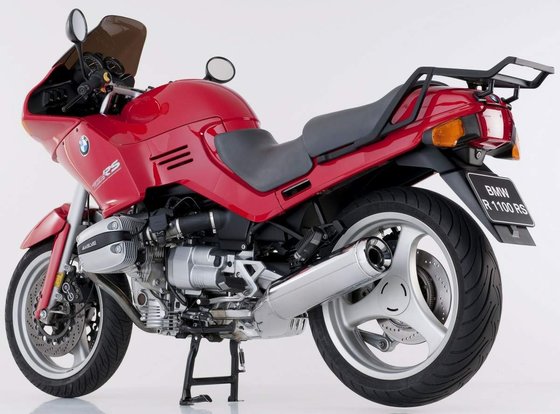
Owning a 30-year-old BMW requires diligence. Here’s what to prioritize:
Critical Service Items
- Valve Clearances: Check every 10,000 km (6,200 mi).
- Intake: 0.15 mm (0.006 in) cold
- Exhaust: 0.30 mm (0.012 in) cold
- Oil Changes: Use 3.75L of SAE 20W-50 (with filter).
- Final Drive: Replace 230 mL of SAE 90 GL-5 oil annually.
- Tire Pressure: 2.2 bar (32 psi) front / 2.5 bar (36 psi) rear (solo riding).
Common Upgrades
- Spark Plugs: Swap to iridium NGK BCPR7EIX for longer intervals.
- Suspension: Aftermarket shocks (e.g., Wilbers) modernize the Paralever’s damping.
- Brakes: Stainless steel lines improve ABS II feel.
Conclusion: A Legacy Worth Preserving
The BMW R 1100 RS isn’t just a motorcycle—it’s a statement. It proved that touring bikes could handle like sportbikes, that shaft drives could be sleek, and that adjustability mattered long before the advent of electronic riding modes.
Today, it’s a testament to over-engineered durability. With proper care (and a steady supply of MOTOPARTS.store’s OEM-spec components), this boxer will keep thrumming for another 100,000 km. Whether you’re chasing horizon lines or Sunday morning twisties, the RS remains a ride that rewards patience and punishes complacency—exactly as a BMW should.
Ride safe, wrench often, and let the boxer’s heartbeat guide your journey.
Specifications sheet
| Engine | |
|---|---|
| Stroke: | Four-stroke |
| Max power: | 67 kW | 90.0 hp |
| Max torque: | 95 Nm |
| Fuel system: | Fuel Injection (Bosch Motronic) |
| Lubrication: | Wet sump |
| Max power @: | 7250 rpm |
| Spark plugs: | NGK BCPR7ET or NGK BCPR7EIX |
| Displacement: | 1085 ccm |
| Max torque @: | 5500 rpm |
| Configuration: | Oposite |
| Cooling system: | Air/Oil cooled |
| Compression ratio: | 10.7:1 |
| Number of cylinders: | 2 |
| Dimensions | |
|---|---|
| Wheelbase: | 1485 mm (58.5 in) |
| Dry weight: | 239 |
| Wet weight: | 268 |
| Seat height: | 780 mm (30.7 in) |
| Overall width: | 920 mm (36.2 in) |
| Overall height: | 1286 mm (50.6 in) |
| Overall length: | 2175 mm (85.6 in) |
| Ground clearance: | 153 mm (6.0 in) |
| Fuel tank capacity: | 23 L (6.1 US gal) |
| Drivetrain | |
|---|---|
| Gear Ratio: | 1st 4.16 / 2nd 2.91 / 3rd 2.13 / 4th 1.74 / 5th 1.45:1 |
| Final drive: | shaft |
| Transmission: | 5-speed |
| Electrical | |
|---|---|
| Battery: | 12V |
| Headlight: | 55/60W halogen |
| Alternator: | 700 W |
| Maintenance | |
|---|---|
| Engine oil: | 20W50 |
| Brake fluid: | DOT 4 |
| Final drive oil: | SAE 90 GL-5, 0.23 L |
| Transmission oil: | SAE 90 GL-5, 0.8 L |
| Forks oil capacity: | 0.94 |
| Engine oil capacity: | 3.75 |
| Engine oil change interval: | Every 9,656 km (6,000 mi) or 2 years |
| Valve clearance (intake, cold): | 0.15 mm |
| Valve clearance check interval: | 24,000 km (15,000 mi) |
| Valve clearance (exhaust, cold): | 0.30 mm |
| Recommended tire pressure (rear): | 2.5 bar (36 psi) solo / 2.9 bar (42 psi) loaded |
| Recommended tire pressure (front): | 2.2 bar (32 psi) solo / 2.5 bar (36 psi) loaded |
| Chassis and Suspension | |
|---|---|
| Frame: | Steel backbone frame with aluminum engine shell |
| Rear tire: | 160/60-18 |
| Front tire: | 120/70-17 |
| Rear brakes: | 1 x 276 mm disc, 2-piston caliper (ABS II optional) |
| Front brakes: | 2 x 305 mm discs, 4-piston Brembo calipers (ABS II optional) |
| Rear suspension: | Paralever swingarm with single-tube gas shock, 125 mm travel |
| Front suspension: | Telelever with Showa twin-tube gas shock, 120 mm travel |



